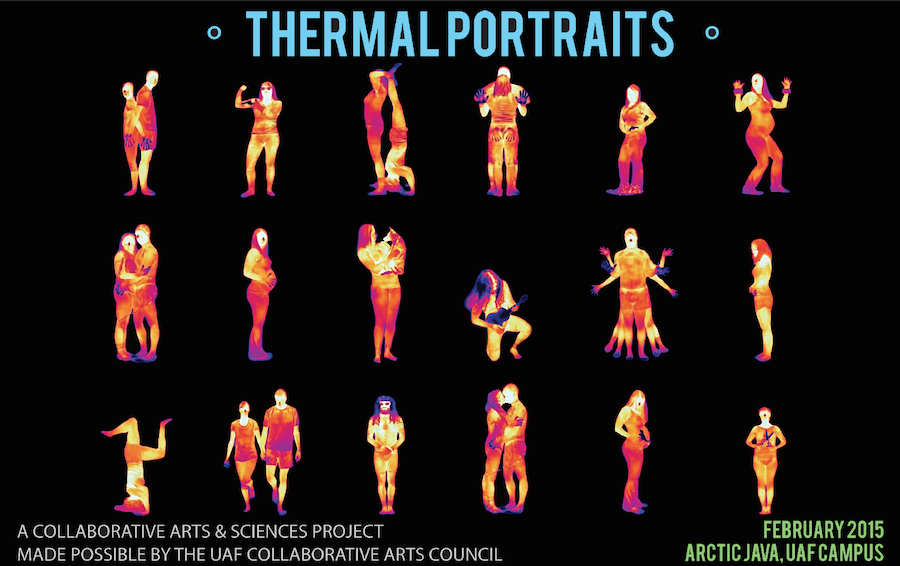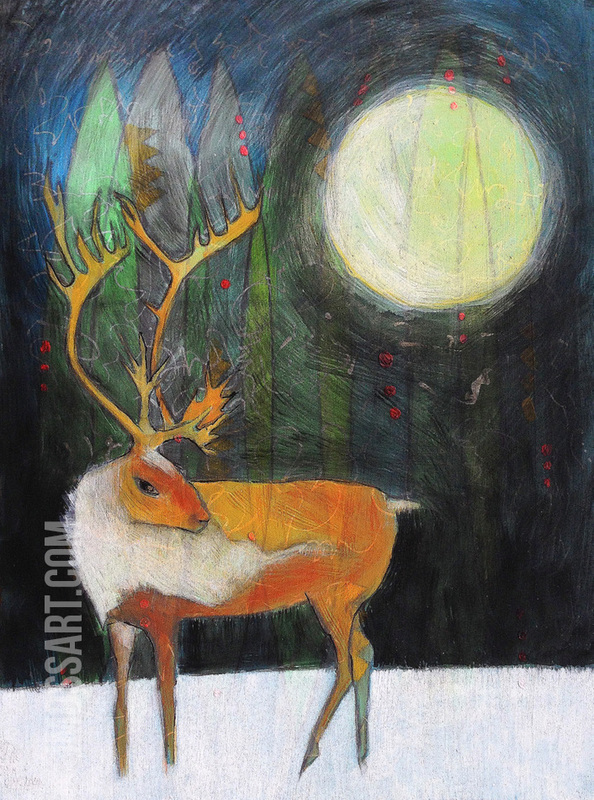THERMAL PORTRAITS - is a collaboration made possible by a grant from the UAF Collaborative Arts Council. The exhibit contains life-size portraits taken with a thermal imaging camera and is on display for the month of February 2015 at the Wood Center, UAF campus.
OVERVIEW
More than 2.1 billion people—nearly 30 percent of the global population—are overweight or obese and this has a $2 trillion annual impact, according to a recent study by McKinsey & Company.1 The Alaska Department of Public Health states that in 2011, 65% of adults in our state were overweight or obese.2 With our collaborative project, we hope to stimulate reflection on the body form by investigating a general relationship between body heat distribution and health. We also wanted to keep it fun and provide visual prompts to enhance the viewing experience.
TECHNICAL PROCESS
Thermal images, also known as thermograms, capture the amount of infrared energy emitted, transmitted and reflected by objects. Colors are mapped to the temperature data received by the camera. Colormaps can be changed depending on what you want to highlight.
For this exhibit, photographs were taken using a professional thermal imaging camera. The camera provides jpgs that are 320 x 240 pixels. The JPG artifacts were removed, the color mapping was altered and the images were turned into vector objects and enlarged.
ABOUT THE COLLABORATORS
Jennifer Moss is an instructional designer at UAF eLearning, adjunct faculty, digital and fine artist with an interest in art-science collaboration and education.
Dr. Kriya Dunlap is a biochemist whose research is based around health relevant research models that incorporate the nutritive properties of indigenous foods and the molecular basis by which they combat age and diet related diseases.
Dr. Michael Harris studies the neurobiology and thermoregulation of respiration including the evolution of air-breathing and adaptations to mammalian hibernation. He is using thermal imaging in current investigations related to brown fat reserves in animals.
REFERENCES
1 How the world could better fight obesity. (n.d.). Retrieved November 21, 2014, from http://www.mckinsey.com/insights/eco- nomic_studies/how_the_world_could_better_fight_obesity
2 Obesity Prevention and Control. (n.d.). Retrieved November 21, 2014, from http://www.dhss.alaska.gov/dph/Chronic/Pages/Obesi- ty/default.aspx
OVERVIEW
More than 2.1 billion people—nearly 30 percent of the global population—are overweight or obese and this has a $2 trillion annual impact, according to a recent study by McKinsey & Company.1 The Alaska Department of Public Health states that in 2011, 65% of adults in our state were overweight or obese.2 With our collaborative project, we hope to stimulate reflection on the body form by investigating a general relationship between body heat distribution and health. We also wanted to keep it fun and provide visual prompts to enhance the viewing experience.
TECHNICAL PROCESS
Thermal images, also known as thermograms, capture the amount of infrared energy emitted, transmitted and reflected by objects. Colors are mapped to the temperature data received by the camera. Colormaps can be changed depending on what you want to highlight.
For this exhibit, photographs were taken using a professional thermal imaging camera. The camera provides jpgs that are 320 x 240 pixels. The JPG artifacts were removed, the color mapping was altered and the images were turned into vector objects and enlarged.
ABOUT THE COLLABORATORS
Jennifer Moss is an instructional designer at UAF eLearning, adjunct faculty, digital and fine artist with an interest in art-science collaboration and education.
Dr. Kriya Dunlap is a biochemist whose research is based around health relevant research models that incorporate the nutritive properties of indigenous foods and the molecular basis by which they combat age and diet related diseases.
Dr. Michael Harris studies the neurobiology and thermoregulation of respiration including the evolution of air-breathing and adaptations to mammalian hibernation. He is using thermal imaging in current investigations related to brown fat reserves in animals.
REFERENCES
1 How the world could better fight obesity. (n.d.). Retrieved November 21, 2014, from http://www.mckinsey.com/insights/eco- nomic_studies/how_the_world_could_better_fight_obesity
2 Obesity Prevention and Control. (n.d.). Retrieved November 21, 2014, from http://www.dhss.alaska.gov/dph/Chronic/Pages/Obesi- ty/default.aspx


 RSS Feed
RSS Feed